EARLY HISTORY (1971-1999)
In 1971, while waiting for his doctoral thesis to be assessed by the University of Manitoba, Peter Laznicka undertook a short-term contract of work with Australian Selection Trust, traversing the eastern seaboard of Australia from Cape York Peninsula in the north, to the island of Tasmania in the south. As an aid to memory, he compiled suites of small samples onto sheets of stout cardboard as he went. Not only did those assist Peter in making objective comparisons over vast tracts of country, but provided a medium through which company geologists could learn and contribute their own experience. This period marked the birth of DM and cemented the importance of empiricism in Data Metallogenica's approach to geological data. Sets of mini samples in time became known as the Lithotheque collection, still at the core of DM's mineral deposit information system. Early sets included many lithological samples. Later, collecting focused more closely on the mineral deposits themselves, but lithology continued to be well represented as an important dimension of regional setting.
The first sample sets were still mounted on original cardboard (now on aluminium sheets) when Data Metallogenica and the Laznicka family moved to Australia in mid-1999. Browsing Lithotheque plate sets #1 to #77 is an amazingly accessible traverse across a continent, which brings home the power to instruct of such a vast range of lithologies and deposits organised like a book library. To take just one example: side by side can be examined, the Herberton tin district, Georgetown Inlier, Mt Isa, Charters Towers, Ravenswood, Gympie, New England, Broken Hill, the Lachlan fold belt of New South Wales, Cobar, Hill End, Captain's Flat, Melbourne Trough, Zeehan, Renison Bell, and Rosebery. Even more tellingly, mines such as Captain's Flat (Zn-Pb-Cu VMS) in New South Wales, long closed and rehabilitated, signal the strategic strength of DM to preserve samples from deposits no longer accessible for later generations of explorers and educators.
On his return from Australia and successful acceptance of his thesis, Peter was appointed Assistant Professor of Geology in the Department of Earth Sciences at the University of Manitoba, where in 1974 he published the blueprint for what was to be the future Data Metallogenica information system. It was entitled, "LITHOTHEQUE - a System of Rock and Mineral Specimens Arrangement in Geological Education, Documentation and Exploration", Publication No. 5 for the Centre for Precambrian Studies. As Peter put it in his report:
"The word 'Lithotheque' (equivalent to bibliotheque) has been used for a system (library) of plates carrying rock or mineral specimens."
"… a collection … arranged and permanently mounted on book-size…plates…designed to be stored in simple holders on bookshelves…(where) ease of handling…(is) comparable…to similar properties of book or report libraries."
"… collect an all-embracing set of mini-specimens covering the entire petrography and mineralogy of an outcrop, mine, stratigraphic unit, etc., and add a few ordinary size specimens of selected rocks and minerals for special purposes."
"Fifteen carefully selected mini-specimens show always many more features than a single, large specimen."
"Specimens, more than anything else, can confirm or disprove the similarity of ore deposits; the published literature often fails because geologists….use different terminology."
The Lithotheque collection at that time (1974) contained 7,500 mini-specimens, or approximately 10% of what it had grown to by January 2003, and is being added to all the time.
For more than thirty years Peter had travelled the world at every opportunity, collecting samples from mineral deposits and searching out information. What Peter and his wife Sarka (also a geologist) achieved prior to his retirement from the university in 1999 is amazing.
Following his wish that DM remain in the public domain, Peter Laznicka approached AMIRA International in 1997 to investigate options for this to happen. AMIRA and the Australian Mineral Foundation (a sister not-for-profit educational group established by industry for technical training purposes) then together funded a subsequent visit to Australia by Peter Laznicka in 1998 to present to major companies in Adelaide, Brisbane, Melbourne, Perth and Sydney. As a result of the encouraging response by Australian industry and government agencies, AMIRA and the AMF agreed to purchase the existing physical collection from Peter Laznicka (at significantly less than other private offers and at a major discount to its replacement value) in order to keep the unique collection in public hands for the general benefit of all involved in the mining industry. In addition, the Laznicka family was supported in its move with the collection from Winnipeg to Adelaide in May 1999 where the collection was established at the AMF to be expanded and utilised in industry training courses.
THE NEXT EXPANSION PHASE (1999-2004)
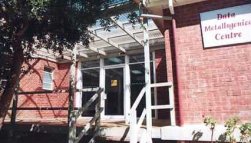 The original Data Metallogenica Centre in Adelaide
The original Data Metallogenica Centre in Adelaide
The original Data Metallogenica Centre in Adelaide, South Australia opened its doors in December 1999, the culmination of efforts by AMIRA International and the Australian Mineral Foundation, and with grant assistance from the government of South Australia. Development funding for an initial period of 3 years was provided by contributions from almost 70 companies and institutions around the world. The initial AMIRA projects (P554, P554A) to fund this program were lead by Dr Kerry O’Sullivan at the AMF, and supervised by Dr Alan Goode (AMIRA).
Funding in the foundation stages has been made possible through the generous support of over 100 large and small mining and exploration companies, government institutions, and learned & professional societies around the world, managed through two AMIRA collaborative projects:
AMIRA P554 (1999-2002) - the acquisition and transport of the collection in May 1999, the establishment of the Data Metallogenica Centre, the collection of further material from Australia, South America and Africa, the digital photographing and PIMA spectral measurement of the collection, the development of the DM website, and its launch for sponsors in July 2002.
 The original Data Metallogenica Centre in Adelaide
The original Data Metallogenica Centre in Adelaide
AMIRA P554A (2002-2004) - the continued collection and photography of further material from Australia, Europe and elsewhere and the major addition of supporting data. Public access to the website was launched at the Prospectors & Developers Association of Canada (PDAC) Convention in Toronto in March 2003. Sponsorship funds were augmented in this transition phase through public web subscriptions.
Data Metallogenica is required to be financially self-sufficient such that subscription and sponsorship revenues must cover running costs. As a not-for-profit minerals industry research association which receives no government grant, AMIRA International needs the support of industry and teaching institutions worldwide for it to continue fulfilling the vision of providing unique information to future generations of explorers and educators.
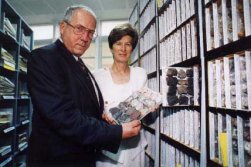 Peter and Sarka Laznicka
Peter and Sarka Laznicka
By 2004 The Centre housed approximately 70,000 rock samples, 1,500 thin and polished sections, a large literature collection, 30-years' worth of field photography, 140 shelf-metres of library, a map collection, and an archive of newly created digital rock sample images. It had a 'viewing room' with excellent natural light, microscopes, and facilities for making presentations to small groups.
Sample-sets were drawn from nearly 4,000 mineral deposits of all types in 70 countries on all inhabited continents. Most were collected personally by Peter Laznicka. His philosophy of seeking truly representative samples of ores, alteration, host rocks and regolith from each deposit, provided important consistency and a unifying strength to the sample base that was rarely found at this scale of development. The major mines of the world, understandably, were well covered, but unusually this coverage extended to minor occurrences, thereby providing important breadth to what might be seen in any given mineral district.
 The Hon. Rob Kerin at the opening of the DM Centre, flanked by Dr Max Richards (Chairman, AMIRA) and Mr Alister McLeod (Chairman, AMF)
The Hon. Rob Kerin at the opening of the DM Centre, flanked by Dr Max Richards (Chairman, AMIRA) and Mr Alister McLeod (Chairman, AMF)
The Data Metallogenica physical collection contains not just one sample collection but two, and each is designed to address a different information need:
The Lithotheque Collection of mini-samples is the most extensive. It houses 90% of all samples which are arranged in sets of 20, permanently bonded to aluminium sheets that fit into slotted shelves. Most Lithotheque sets come from a single mine or mineral occurrence but are well supported by a useful number of district lithology sets. Digital imaging of the entire Lithotheque collection was carried out to commercial standards using an in-house photo-studio and the highest resolution digital scientific camera then available. Colour calibration and manual proofing were employed in the quality control process. Images are of extremely high resolution and use advanced data compression for the web. In addition, each 18 Mb photographic source file is parent to six smaller ones of different type and quality, designed to meet a range of identified needs.
The Macrotheque Collection contains approximately 8,000 hand-specimens ordered in 365 sets by geological setting. Only selected of these sets have so far been captured as digital images.
The Centre was officially opened by the Hon. Rob Kerin, Deputy Premier and Minister for Primary Industries, Natural Resources and Regional Development, South Australia on 15 December, 1999.
This first AMIRA Project (P554) set out to purchase the physical collection, revise and augment deposit information, carry out semi-quantitative mineralogical measurement on samples, digitally image the Lithotheque collection, and established a web-based Data Metallogenica web site and subscriber database. The physical collection was augmented during the initial AMIRA projects through Peter Laznicka visiting and collecting from additional deposits in Australia, South America, Africa and Europe.
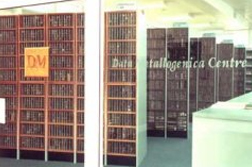
The website was achieved by July 2002, when a searchable database of 20,000 files of images, text and measurement (approx 2.5 Gb) was launched for the use of project sponsors. A further 2-year follow-on program of sponsored development (AMIRA Project P554A) commenced in December 2002, tasked with adding significant new mineral deposit information to the database: notably, full deposit descriptions, field photo-galleries, plans, sections and regional summaries. Samples from missing deposits continued to be added and the important program of high resolution digital photography of samples was extended. In March 2003 the Toronto PDAC Convention and Trade Show in Canada saw the official launch of the web database to public subscribers.
This P554A project was completed in November 2004. During the later course of the project, the AMF was unfortunately placed into liquidation and full ownership of the collection passed to AMIRA International in 2005.
By this stage, over 100 companies, government organisations and learned/professional societies from around the world had become Foundation Sponsors of the project. A full list of Foundation Sponsors and Donors is provided on the homepage (including former sponsors now acquired or controlled by other companies as well as those sponsoring the current AMIRA P1040 project).
Data Metallogenica receives no government subsidy and after the original sponsorship concluded in January 2005 had to cover its own running costs through annual subscription revenues set by the sponsors. Its parent organisation, AMIRA International, as a not-for-profit minerals industry research association, needed industry and teaching institutions worldwide to support DM through their active participation for it to continue to fulfil the vision of providing unique information to succeeding generations of explorers and educators.
PHASE THREE (2004-2012)
Following the liquidation of the AMF, Data Metallogenica was evicted from the custom Data Metallogenica Centre in Glenside, Adelaide in 2005 by the new owners of the building, with the physical collection being placed in storage after careful packing. The website continued to operate.
During the period up to the Global Financial Crisis in 2008, Data Metallogenica was able to fund its continued expansion through its own generated subscription funding. While still generating similar significant funding from annual subscriptions after 2008, for various reasons including retrenchment of staff by AMIRA there was little expansion of Data Metallogenica, although several significant but ultimately unsuccessful efforts were made to re-house the physical collection with the government in South Australia. Some growth continued in the physical collection, with DM continuing to purchase occasional Lithotheque plates prepared by Peter Laznicka following personal visits by him to different parts of the world.
Despite these setbacks and with little promotion, website usage of the information on Data Metallogenica continued to grow steadily. Website stats analysis showed daily usage continued to progressively improve from inception of the first website in 2002 (a positive and encouraging trend because it showed regular and repeated use rather than more spasmodic usage).
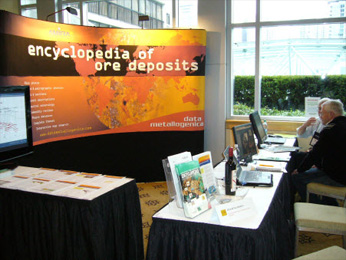 An annual trade booth at AME BC’s Mineral Exploration Roundup in Vancouver since 2006 has proved popular with attendees in promoting the activities and aims of Data Metallogenica.
An annual trade booth at AME BC’s Mineral Exploration Roundup in Vancouver since 2006 has proved popular with attendees in promoting the activities and aims of Data Metallogenica.
The overall web statistics were encouraging for a technical website in these circumstances with over 760,000 hits in 2011 (2000 per day, almost 90 per hour) from 108,000 visitors, over 25,000 of which visited more than once. Those visitors with subscriptions downloaded 25 Gb of data (average 70 Mb per day).
The visits from the main regular corporate subscribers in 2011 indicated how much value those companies got from the site for their staff re reference and training (more than some of their managers realised) and also indicated potential opportunities for other groups to utilise DM more productively than they currently did. The good thing about technical websites like DM is that every year more information becomes available and therefore the site becomes more and more useful and valuable.
In addition, sponsors of P554A were able to provide indefinite free access as a “gift” to universities in developing countries in Africa, Asia (including Russia), South America and eastern Europe. Apart from “goodwill” provided by the sponsors, this access to a major technical resource will potentially result in better employees for exploration or mining in those countries, and so will be of mutual benefit. Together with universities in developed countries in North America, Australasia, South Africa and western Europe, DM is now used by over 50 universities around the world for training and reference, an important aid in education. The free access privilege has been extended again in P1040 which should allow even wider use in education in the lesser developed world.
4. RENEWED DEVELOPMENT (2012- )
 DMITRE Core Library, Glenside (Adelaide), South Australia
DMITRE Core Library, Glenside (Adelaide), South Australia
The stagnation of website growth after the GFC was well recognised, and was also accompanied by some IT issues due to bottlenecks in data addition in particular. Available technical data on global deposits far outstripped DM’s capacity to add to the website in the current financial model, despite its proven self-sufficiency over the previous eight years.
As a result, a new special AMIRA project P1040 (Building the Global Encyclopaedia of Ore Deposits) was established to solve these issues and to accelerate data addition to DM. Sufficient funding from over 50 sponsors was obtained to allow this project to start in June 2012.
Early focus has been on development of a new website. This will allow much easier addition of new files by others as well as other advantages such as improved “searchability”. Photographs of samples from additional deposits from North Africa, the Middle East, East Asia, South America and elsewhere are also now available. The new website is available in essentially any language (eg all European and Scandinavian languages, Russian, Arabic, Farsi, Chinese, Hindi, Japanese, Swahili, Afrikaans etc), as are all information contained in supporting pdf documents, so will be of significant assistance in global reference and education.
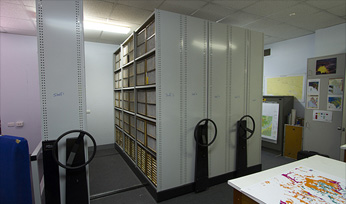 Lithotheque collection in the Core Library
Lithotheque collection in the Core Library
Support to students as the next generation of economic geoscientists in industry and academia has also been made available in various ways, together with technical support being provided where necessary to some of the industry’s “elder statesmen” so their contributions can be preserved in DM.
The ultimate aim in this project is for DM to become a “wiki” and allow others to add and preserve their technical data from deposits around the world, as well as to become a major resource for reference, training and education. Future plans for Data Metallogenica are for an ever widening range of linked industry website information sources, including for the fields of mining, mineral processing and environment.
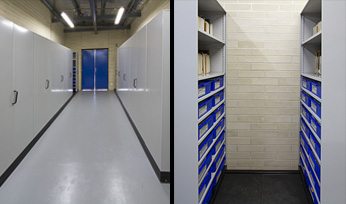 Macrotheque collection and literature folders in the Core Library
Macrotheque collection and literature folders in the Core Library
The physical collection is again available for inspection in South Australia. The South Australian Government (through DMITRE) has fully unpacked the physical collection. The new storage at the Glenside Core Library in Adelaide is first-class, and AMIRA would like to thank David Groom and Georgina Gordon for their efforts in establishing the new compactus facilities and for unpacking the Lithotheque and Macrotheque collections. It was very pleasing, that despite years of storage in shipping containers, there was extremely little damage (nothing irreversible) to the physical collection – thanks should go to Kerry O’Sullivan and his helpers for the superb job they did in packing and protecting the collection in 2005 when the AMF went into liquidation and the original DM Centre was closed. The collection is still owned by AMIRA on behalf of the minerals industry, and is being stored by DMITRE at their cost and under their security for an initial 5-year term – AMIRA is very grateful for their help and assistance in getting to this point despite several disappointments re other possible options along the way. The collection is available for inspection, under DMITRE supervision, for sponsors and professional geologists utilising the Core Library.
Agreement was reached in 2013 for the residual Rod Kirkham copper collection of several thousand samples in Vancouver to be shipped to Adelaide and added to DM in due course.
For further information please contact: Imran Hussain